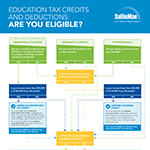Are You Eligible? Sallie Mae Reminds Families About Often-Overlooked Education Tax Credits and Deductions
Higher Education Credits and Deductions Can Add Up to $1,460 in
Average Tax Savings
NEWARK, Del.–(BUSINESS WIRE)–If you paid tuition, fees, or interest on a student loan last year, you
may be eligible for higher education tax credits or deductions. To
ensure families don’t inadvertently leave money on the table, Sallie
Mae, the nation’s saving, planning, and paying for college company,
today released new information to help families understand and take
advantage of higher education tax credits and deductions.
According to the College Board, students and families saved about $17.9
billion in education credits and deductions in 2013, with the average
family saving about $1,460. Yet, according to “How
America Pays for College,” an annual study conducted by Sallie Mae
and Ipsos, only 37 percent of American families used tax credits and
deductions as a way to help cover tuition costs in 2014-15.
“For families with children in college, tax season can bring additional
savings through education tax credits and deductions, and those savings
can be meaningful,” said Xavier Epps, C.E.O. and founder, XNE Financial
Advising, LLC. “It’s worth doing a little homework and research to see
if you qualify.”
Students and families should explore these various tax options in order
to capitalize on savings. Families should keep in mind they may not
claim more than one credit for the same student in any one year, and
can’t take both a deduction and a credit in the same year.
-
The American Opportunity Tax Credit. Eligible taxpayers may
qualify for a maximum annual credit of $2,500 per student for the
first four years of higher education. To be eligible, the student must
be enrolled at least half-time in a degree or other recognized
educational credential. The credit can be applied to course-related
books and supplies in addition to tuition and fees. To receive the
full credit, a single taxpayer can have 2015 income of up to $80,000,
or a partial credit is available for income up to $90,000. For married
filers, those with and adjusted gross income up to $160,000 are
eligible for the full credit, and up to $180,000 for a partial credit. -
The Lifetime Learning Credit. Eligible taxpayers may qualify
for up to $2,000 per tax return to help pay for undergraduate,
graduate, and professional degree courses – including courses designed
to improve job skills. There is no limit on the number of years an
individual can claim the Lifetime Learning Credit. The Lifetime
Learning Credit is available to taxpayers with modified adjusted gross
income of less than $65,000, or $130,000 if filing jointly. The credit
is reduced gradually for single filers making more than $55,000, and
for joint filers making more than $110,000. -
Student Loan Interest Deduction. Student loan borrowers may be
eligible for up to $2,500 in student loan interest deductions to
offset income subject to tax. Available for both federal and eligible
private education loans in repayment, single filers with a modified
adjusted gross income of less than $80,000 and those with a joint
modified adjusted gross income less than $160,000 qualify for this
deduction. In 2013, 11.5 million taxpayers deducted $11.6 billion in
student loan interest, generating about $1.7 billion in tax savings. -
Tuition and Fees Deduction. Students and families can use up to
$4,000 in expenses for higher education to offset income subject to
tax. This deduction is taken as an adjustment to income; however, an
individual does not need to itemize other deductions. Individuals with
a modified adjusted gross income of up to $80,000 and those with a
joint modified adjusted gross income of up to $160,000 can file for
this deduction.
“Higher education tax deductions and credits are intended to reduce
college costs, so study up and claim them if you are eligible,” said
Martha Holler, senior vice president, Sallie Mae.
Additional information on education tax credits and deductions is
available through the Internal Revenue Service Publication 970, Tax
Benefits for Education, or through a personal tax advisor.1
On March 9 at 2 p.m. EST, Sallie Mae and XNE Financial Advising, LLC
will host a Twitter chat to discuss how to make the most of higher
education tax credits and deductions. Follow the chat using the hashtag
#TaxChat.
Sallie Mae (NASDAQ: SLM) is the nation’s saving, planning, and
paying for college company. Whether college is a long way off or just
around the corner, Sallie Mae offers products that promote responsible
personal finance including private education loans, Upromise rewards,
scholarship search, college financial planning tools, and online retail
banking. Learn more at SallieMae.com.
Commonly known as Sallie Mae, SLM Corporation and its subsidiaries are
not sponsored by or agencies of the United States of America.
1 This information is not meant to provide tax advice.
Whether filing jointly or separately, consult with a tax advisor for
education tax credit and deduction eligibility
Contacts
Sallie Mae
Rick Castellano, 302-451-2541
rick.castellano@salliemae.com



















